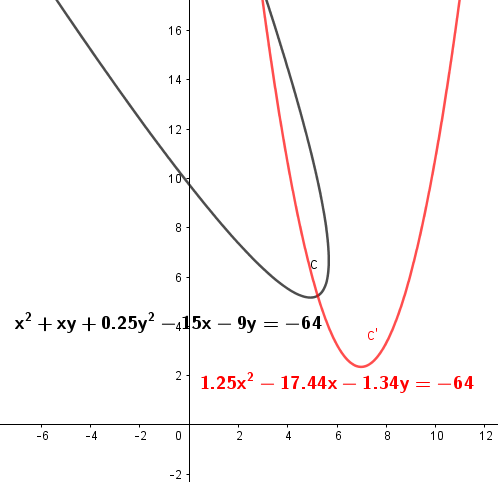Rectify the Conic
We are working with the conic $$Ax^{2}+Bxy+Cy^{2}+Dx+Ey+F=0 \tag{1} \label{1}$$ We need to “straighten up” the conic in order to easily find reference points, such as its vertex, focus, latus rectum, etc. Knowing an angle of rotation, we can counter-rotate the conic equation with a “rotation matrix”. In Axes Rotation we showed how to obtain equations for rotation and we showed this substitution for how to rotate an equation. $$\begin{array}{c} x=x_{1}\cos(\theta)-y_{1}\sin(\theta)\\ y=x_{1}\sin(\theta)+y_{1}\cos(\theta) \end{array} \tag{2} \label{2}$$ Equation $\eqref{2}$ shows how to rotate an equation into axis alignment after having calculated $\theta$ from the relation $$\cot(2\theta)=\frac{A-C}{B}. \tag{3} \label{3}$$ Be sure to use a number (in radians) for $\theta$, because we want the $xy$ term to drop out. The calculation that we did to get $\theta$ $\eqref{3}$ is what will cause that to happen. Let's substitute into the parabola $$x^{2}+xy+y^{2}/4-15x-9y=-64. \tag{4} \label{4}$$ We have already calculated $\theta=26.57^{\circ}$, which, if we keep all of the symbolic calculation is $$\theta=\frac{\arctan\left(\frac{4}{3}\right)}{2}.$$ In making this substitution, I have omitted the subscripts on $x$ and $y$ for clarity but, we are substituting into Eq $\eqref{4}$, replacing $x$ with $x\cos\theta-y\sin\theta$ and replacing $y$ with $x\sin\theta+y\cos\theta$ as shown in $\eqref{2}$. $$\begin{aligned} & \left(x\cos\theta-y\sin\theta\right)^{2}\\ & +\left(x\cos\theta-y\sin\theta\right)\cdot\left(x\sin\theta+y\cos\theta\right)\\ & +\frac{1}{4}\left(x\sin\theta+y\cos\theta\right)^{2}\\ & -15\left(x\cos\theta-y\sin\theta\right)\\ & -9\left(x\sin\theta+y\cos\theta\right)\\ & =-64 \end{aligned} \tag{5} \label{5}$$ Now it turns out that $\cos\left(\arctan(4/3)/2\right)\approx=0.89443$ and $\sin\left(\arctan(4/3)/2\right)\approx0.44721$. Using these numbers we can simplify $\eqref{5}$. $$\begin{aligned} & \left(0.89443x-0.44721y\right)^{2}\\ & +\left(0.89443x-0.44721y\right)\left(0.44721x+0.89443y\right)\\ & +\frac{1}{4}\left(0.44721x+0.89443y\right)^{2}\\ & -15\left(0.89443x-0.44721y\right)\\ & -9\left(0.44721x+0.89443y\right)\\ & =64 \end{aligned} \tag{6} \label{6}$$ Let's just continue to expand $\eqref{6}$ because it gets better. $$\left(\begin{array}{c} 0.8x^{2}-0.8xy+0.2y^{2}\\ +0.4x^{2}+0.6xy-0.4y^{2}\\ +0.05x^{2}+0.2xy+0.2y^{2}\\ -13.42x+6.71y\\ -4.02x+8.05y\\ =-64 \end{array}\right) \tag{7} \label{7}$$ If we look at the $xy$ terms we will see that they cancel out. Expanding everything, and combining terms we get $$1.25x^{2}-17.44133x-1.34164y=-64$$ which is the equation of an open-up parabola.
